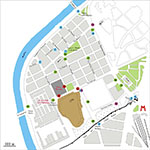

 HISTORY OF THE RIONE TESTACCIO
HISTORY OF THE RIONE TESTACCIO
The valley of Testaccio spreads out for 600,000 mq and shows an urban fabric rich of historical evidences. From the 2nd century BC, and then between the 1st and 2nd century AD, when the ancient docking of Rome near the Foro Boario became inadequate for the city needs, the Testaccio plain was destined to the construction of a new port (Emporium), of buildings for goods conservation and storage (Porticus Aemilia, Horrea Galbana, Lolliana, Severiana, etc.), and of a large organized dump of imperial oil amphoras (Monte dei Cocci or Monte Testaccio).
Between the 5th and the 7th century AD, the plain was involved in a gradual process of ruralization, and since the Middle Ages it was used for setting up vegetables gardens and vines. A part of the present rione was left as public recreation ground, and was therefore known with the name “Prati del Popolo Romano” (Meadows of Roman People).
After the Unity of Italy, the city plan of 1871 stated that the area had to be used for housing industrial buildings and the connected working class houses.
The modern and functional Mattatoio was built on the base of the project by the Architect G. Ersoch. On the contrary, the working class houses were not provided with adequate facilities (water supply, elettric grid, sewerage, etc.), causing precarious and inadequate living conditions.
The Fascist regime promoted a new building phase, corresponding to the gradual settling of middle class office-workers into the quarter and to the consequent gradual social transformation.
Today Testaccio offers new and varied cultural contexts, such as the Faculty of Architecture of the University “Roma Tre”, The European Institute of Desing, and a part of the Museum of Contemporary Art of Rome, showing great momentum in the evolution of its social, commercial and cultural potentials.

